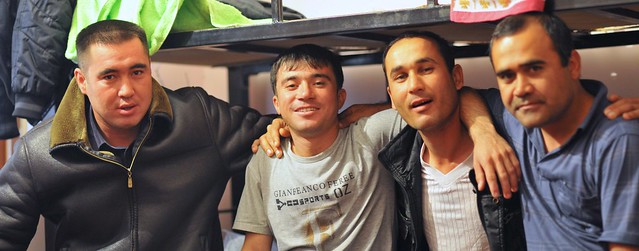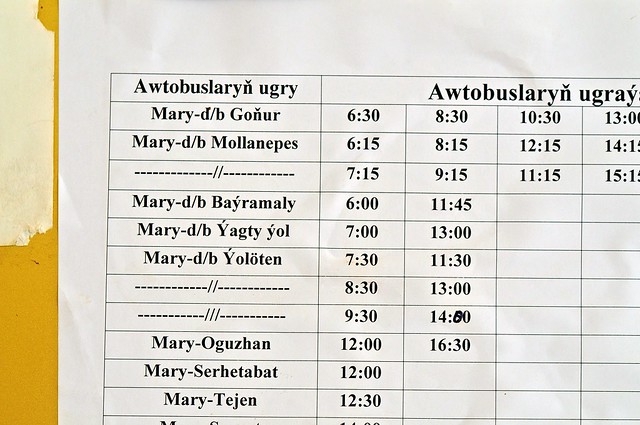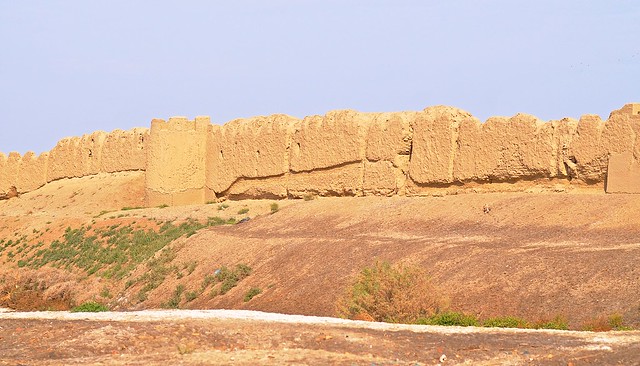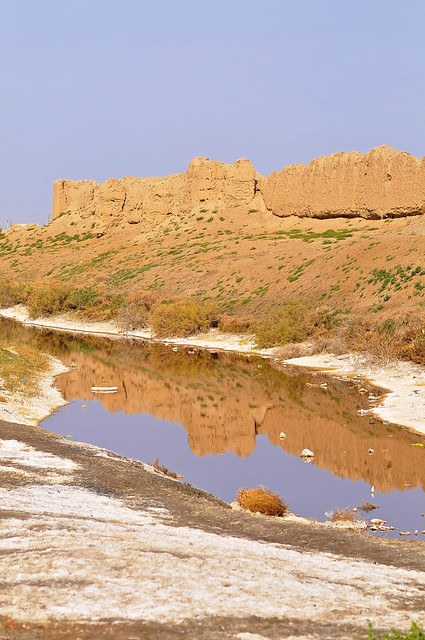I first heard of Bam back in 2003, when I read a piece in the International Herald Tribune about its destruction in an earthquake. I knew nothing of Iran, and was pretty surprised to learn that such a place as Bam—an ancient citadel with roots as far back as 500 BC, and with most of the surviving mud-brick buildings dating from the Safavid era (1501–1736). I promptly forgot about Bam, but I was reminded of it when I started to leaf through my Lonely Planet and trying to figure out what I should see in Iran. And, in truth, the memory of that news report probably gave me false expectations, as in my mind I had conflated the modern town and its casualties with the ancient town, and come away with impression that Bam had been a town where people had continued to live in ancient buildings until the quake. This false memory was reinforced by a rather vague description in Lonely Planet, which describes that the quake's destroyed the mud brick homes in which most people lived, and forced them to build steel-framed buildings to replace them, but failing to mention that these mud-brick homes were less than 50 years old.
Anyway, the reality is that most of the older buildings below the citadel were in ruined or semi-ruined condition well before the 2003 quake, and that only the citadel itself was in good repair at that time. The same is true for nearby Rayen, which was largely spared in 2003.
Bam isn't a major town, and almost all buses will be running through to Zahedan, so the de facto bus stop is a roundabout on the south edge of town. From there is a a few kilometers to Lonely Planet's highly-recommended place to stay, Akbar Tourist Guesthouse. Akbar's may actually be the best option in Bam, but given the dearth of options I don't think that's saying much.
Akbar said he would give me a discount to 250,000 rial. If he had been there when I arrived, I probably would have walked away and returned to Kerman in the evening, but it was now late afternoon and I wouldn't be able to see the Arg before it got dark. So I ended up agreeing to stay.
In all honesty, his place was pretty rough. I know there was an earthquake, but it happened nine years earlier, in 2003. Construction was ongoing and the stairs were completely open on one side, with not even a railing for safety. The rooms were already quite dingy and dirty, with stained carpets. The shared bathrooms had inoperative toilets and showers, and were full of mosquitos. They also lacked hot water, so after I had dropped my bag Akbar let me use one of the bathrooms in a nicer room, but I had to chose if I wanted to use it in the evening or the night. As someone who showers in the morning and the evening, this sucked. In all, it was pretty unimpressive, at any price.
But whatever. I headed out to see the Arg, which was another three or four kilometers north of Akbar's. Outside of the historical areas, Iranian cities aren't especially attractive, and Bam was even uglier than most. No doubt this is a harsh assessment in light of the 2003 earthquake (but given the Iran's huge population boom—half the population is under 25—and concomitant building expansion, this isn't as unfair as you might imagine), but the area between the Arg and the highway has a very industrial feel.
Anyway, the reality is that most of the older buildings below the citadel were in ruined or semi-ruined condition well before the 2003 quake, and that only the citadel itself was in good repair at that time. The same is true for nearby Rayen, which was largely spared in 2003.
From Kerman to Bam
The bus station in Kerman is a bit of a mess, as it is unusually spread out, with different ticket offices in different for different companies and destinations. There are also touts outside offices trying to get people onto their buses before they leave, which can be slightly confusing. Buses to Bam run fairly frequently, but I ended up waiting for about an hour for mine to leave.Bam isn't a major town, and almost all buses will be running through to Zahedan, so the de facto bus stop is a roundabout on the south edge of town. From there is a a few kilometers to Lonely Planet's highly-recommended place to stay, Akbar Tourist Guesthouse. Akbar's may actually be the best option in Bam, but given the dearth of options I don't think that's saying much.
Mr. Akbar's Tourist Guesthouse
I arrived at the guesthouse at about the same time as a couple of Iranians who arrived by car, but we were both stymied by no one being there, so we waited in the courtyard. It was well over an hour before anyone arrived, and the Iranian pair checked in first. I received a bit of a shock when I was told that the price the cheapest room was 300,000 rial, as the recent Lonely Planet suggested the price should be about 130,000 rial—clearly he was doing something like Vali and boosting his prices. Of course, this was especially shocking given that the triple room in Kerman had been a total of 270,000 rial.Akbar said he would give me a discount to 250,000 rial. If he had been there when I arrived, I probably would have walked away and returned to Kerman in the evening, but it was now late afternoon and I wouldn't be able to see the Arg before it got dark. So I ended up agreeing to stay.
In all honesty, his place was pretty rough. I know there was an earthquake, but it happened nine years earlier, in 2003. Construction was ongoing and the stairs were completely open on one side, with not even a railing for safety. The rooms were already quite dingy and dirty, with stained carpets. The shared bathrooms had inoperative toilets and showers, and were full of mosquitos. They also lacked hot water, so after I had dropped my bag Akbar let me use one of the bathrooms in a nicer room, but I had to chose if I wanted to use it in the evening or the night. As someone who showers in the morning and the evening, this sucked. In all, it was pretty unimpressive, at any price.
But whatever. I headed out to see the Arg, which was another three or four kilometers north of Akbar's. Outside of the historical areas, Iranian cities aren't especially attractive, and Bam was even uglier than most. No doubt this is a harsh assessment in light of the 2003 earthquake (but given the Iran's huge population boom—half the population is under 25—and concomitant building expansion, this isn't as unfair as you might imagine), but the area between the Arg and the highway has a very industrial feel.
 |
| View from the southwestern edge of the Arg complex. Thee walls are one of the few sections of town aside from the citadel that had been reconstructed. |
The naming of the Arg is a bit confusing, as Arg (or Ark) is usually used to refer to a citadel, but in Bam the entire ancient city complex is referred to as the Arg-e-Bam. The ancient city itself contains a citadel on the northern end, which makes it a little difficult to differentiate whether you're talking about the citadel within the ancient city, or just the entire ancient city complex.








